Key 90s Fashion Trends
With key 90s fashion trends influences ranging from grunge to minimalism, the decade’s styles reflected a shift towards authenticity and individuality. The ’90s were a time of vibrant self-expression and fashion experimentation.Clothing wasn’t just about aesthetics; it was an extension of one’s personality, offering a canvas for personal expression.
Iconic Clothing Styles
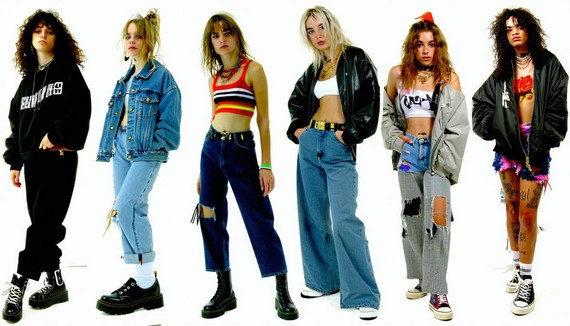
90s fashion styles collage
Plaid shirts became a staple of the 90s, thanks to the grunge scene led by bands like Nirvana and Pearl Jam. They were often paired with ripped jeans and combat boots, creating a casually rebellious look. The unkempt style mirrored the cultural shift away from the glamour of the previous decade, embracing authenticity over opulence.
Slip dresses swayed into the 90s fashion scene, exemplified best by Kate Moss. This versatile piece, often worn with trainers or chunky boots, blended elegance with a laid-back attitude. The silhouette became a go-to for both high fashion designers and high street brands alike.
Crop tops dominated the 90s, unapologetically flaunting midriffs everywhere from malls to music videos. Paired with high-waisted jeans or skirts, the look was influenced by the fitness craze that swept through the decade, popularized by the likes of the Spice Girls and Destiny’s Child.
Platform shoes added height and an edgy statement. Spice Girls fans will remember these towering shoes as a symbol of pop culture. Whether you preferred Baby or Scary Spice, there’s no denying the confidence boost that came with every step.
The influences of hip-hop also made their mark on mainstream fashion. Oversized trousers, graphic tees, and bucket hats defined a look that was as much about attitude as it was about aesthetics. TLC and Aaliyah were key in bringing this street style to the forefront, making it accessible and appealing to fans and fashionistas alike.
Icons like Winona Ryder and Drew Barrymore often mixed high and low key 90s fashion trends effortlessly. They’d wear vintage tees with couture pieces, sparking a movement that democratized fashion—suddenly anyone could combine designer labels with thrift store finds to create something uniquely ’90s yet personal.
Minimalism took off with designers like Calvin Klein and Helmut Lang leading the way, stripping fashion down to its core. With monochrome palettes and simple lines, these styles can still be seen reflected in modern wardrobes today.
Whether embracing the alternative edge of grunge or the streamlined cool of minimalism, the key 90s fashion trends offered something for everyone. It was a time of breaking the rules, mixing styles, and making fashion a form of self-expression. 90s Clothing wasn’t just about what looked good; it was about what felt right and resonated with each individual’s world view.
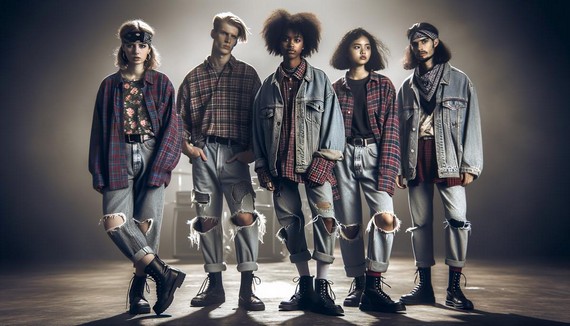
A group of young people wearing grunge-inspired outfits, including plaid shirts, ripped jeans, and combat boots
Influential Accessories In Key 90s Fashion Trends
Accessories brought the final flourish that completed each iconic ’90s look. Bucket hats, once seen atop the heads of rappers like LL Cool J and rockers alike, painted a picture of laid-back cool. This versatile headgear complemented both baggy streetwear styles and more fitted silhouettes, bridging the gap between high fashion and street cred.
Fanny packs, or bum bags as they are known across the pond, were another essential ’90s accessory. Initially seen as purely functional, these waist-pouches quickly became a fashion statement thanks to stars like Sarah Jessica Parker and Gwen Stefani flaunting them in playful ways. Worn slung across hips or even across the shoulders, the fanny pack’s hands-free practicality was matched by its style versatility.
Chunky jewelry was equally at home in the ’90s. Oversized hoop earrings, chain-link necklaces, and bejewelled chokers were the order of the day, each piece a bold declaration of individuality. Tattoo chokers, in particular, became a hallmark of ’90s teen style, wrapping snug against necks across the globe.
Sunglasses were more than a mere shield against the sun—they were an indispensable element of the ’90s accessory arsenal. Rounded frames, slim-line silhouettes, and bold lenses in various tints offered a certain mystique and coolness to celebrity looks. Whether perched on the noses of movie stars or musicians, sunglasses played a key role in evoking both glamour and intrigue.
The rise of branded sportswear turned logos into emblems of status, with names like Nike, Adidas, and Fila emblazoned on caps, trainers, and tracksuits. These brands became a canvas for style statements and a bridge between function and fashion, infiltrating closets with an irreverent energy. As the lines between athletic wear and leisure attire blurred, it became perfectly acceptable to sport a tracksuit as everyday wear.
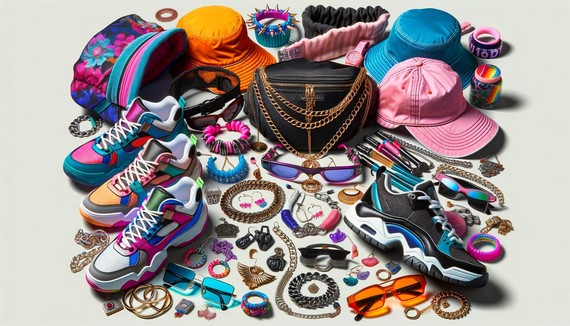
A collection of popular 90s accessories including bucket hats, fanny packs, chunky jewelry, and branded sportswear
Mainstream Key 90s Fashion Trends Influences
In the 90s, the key 90s fashion trends impact of media and celebrity culture on fashion was significant, shaping trends and dictating consumer tastes. Supermodels, musicians, and television shows didn’t just mirror the fashion scene; they became pivotal in its evolution. People didn’t just want clothes; they craved the personas and cachet that came with styles worn by their favorite stars.
Kate Moss, with her androgynous look and nonchalant grace, epitomized the grunge and “heroin chic” aesthetic. Her campaigns with Calvin Klein, particularly for the brand’s minimalist, monochrome collections, turned her into a fashion symbol. Moss’s waif-like figure, combined with Calvin Klein’s simple-yet-striking designs, encapsulated the minimalist ethos that captivated the ’90s.
Musicians exerted profound influence in the key 90s fashion trends, sidelining traditional fashion narratives with their eclectic styles. Bands like Nirvana brought grunge fashion into the mainstream, while pop stars like the Spice Girls promoted pop-punk and rave culture through their bold outfits, making platform trainers and glitter-infused garb popular among fans.
Television shows such as “Friends” and “The Fresh Prince of Bel-Air” served as weekly fashion showcases. Rachel Green’s layered outfits and stylish haircuts, as portrayed by Jennifer Aniston, sparked myriad fashion trends. On another screen, Will Smith’s vibrant outfits and fun-loving persona fueled the massive popularity of streetwear.
The symbiotic relationship between celebrities and designers became more pronounced as high fashion borrowed from street culture, and street culture borrowed right back. When stars endorsed a look, it instantly gained credibility, prompting consumers to mimic the fresh trends and declaring allegiance to the ethos they represented.
As much as the ’90s were about individuality and the subversion of traditional fashion norms, the decade’s eclectic tastes were driven by a desire to adopt something newer, edgier, and more resonant with the zeitgeist. From runways to CDs to TV screens, the influence of media and celebrity culture was omnipresent, shaping not just what people wore, but how they wanted to be perceived.
Ultimately, the key 90s fashion trends taught us that style is deeply personal and rooted in authenticity. Whether through bold accessories or minimalist designs, the era’s fashion continues to inspire today’s trends by reminding us that true style is about being comfortable in our own skin.
Refrerences:
- Menkes S. Grunge: A Success Story. New York Times. 1993.
- Borrelli-Persson L. The Ultimate ’90s Fashion Icons. Vogue. 2018.
- Wilson E. Slip Dressing, From the Boudoir to the Streets. New York Times. 2016.
- Givhan R. The ’90s Are Back: The Return of Minimalism. Washington Post. 2010.
- Cartner-Morley J. How We Fell Back in Love with the 1990s. The Guardian. 2019.
Grunge fashion in the 90s
Born from the gritty music scene of Seattle, Grunge fashion in the 90s embodies rebellion and authenticity. It emerged as a stark contrast to the polished aesthetics of its time, offering a wardrobe that spoke volumes through its casual defiance. The movement’s raw energy was mirrored in its attire, reflecting a cultural shift that resonated deeply with those seeking genuine self-expression.
Grunge fashion in the 90s, rooted in Seattle’s vibrant music scene of the ’80s, offers a compelling blend of nonchalance and authenticity. This style emerged as a quiet rebellion against conventional fashion norms, favouring comfort and individuality over polished appearances. As we revisit this iconic key 90s fashion trend, it’s intriguing to see how it continues to influence modern wardrobes while retaining its original spirit.
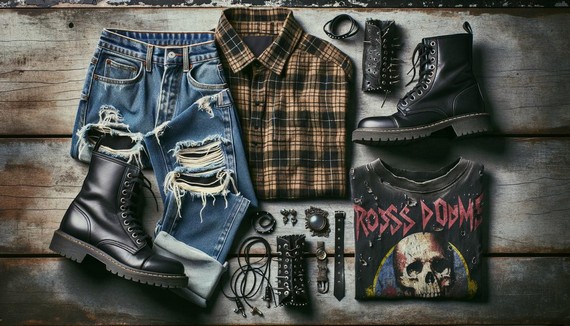
Grunge fashion essentials
Origins and Evolution
Grunge fashion in the 90s originated in Seattle’s music scene in the ’80s, alongside bands like Nirvana and Pearl Jam. It championed a laid-back style that seemed to care little for fashion rules. Kurt Cobain became its poster child, with Courtney Love embodying the queen of grunge chic. The look celebrated thrift store finds: plaid shirts over tattered tees, worn-out jeans, and an overall philosophy that rejected polished looks.
As punk’s influence waned, grunge stepped in with its raw sound and matching aesthetic. It was about messy hair and flannel shirts, mixing gender-neutral layers that questioned the importance of clothing choices. The rainy Seattle climate influenced the style, encouraging practical, layered outfits.
Grunge wasn’t just anti-fashion; it was a subtle protest against consumer culture. It valued music and friendship over flashy labels. In the ’90s, mainstream fashion caught on, with designers like Marc Jacobs bringing grunge to the runways.
By the 2010s, ‘soft grunge’ emerged, incorporating pastel shades and floaty fabrics while maintaining the thrift shop appeal. This evolution attracted a new generation while allowing ’90s kids to revisit their youth with a twist.
Grunge continues to evolve, reminding us that style isn’t always about being polished – it’s about being authentic.
Grunge fashion in the 90s sprouted from the Seattle music scene, channeling the same raw energy into attire as the music of Nirvana and Soundgarden. Once a whisper in the punk legacy, it quickly became a symbol of anti-establishment cool. During the mid-80s, as the glossy sheen of 80s excess wore thin, grunge emerged as a scruffed alternative, reflecting the gritty sound and laid-back defiance of bands from Sub Pop’s garage.
Kurt Cobain and Courtney Love perfectly encapsulated Grunge fashion in the 90s essence—a style that spoke louder with its nonchalance than any billboard scream. Ripped jeans, thrift store flannel, and a general air of “couldn’t give a toss” defined the look. Thrifted attire wasn’t just a fashion choice, but an act of rebellion against capitalism. Even as brands like Marc Jacobs tried to polish grunge for the high street, the movement maintained its attitude.
Women like Courtney Love brought their own twist with the kinderwhore look, where girlish babydolls met defiant rips and bold makeup. Vintage slips paired with untamed hair turned heads away from conventional norms towards individual expression.
The music scene fueled the unkempt aesthetic. Bands didn’t just play grunge—they let it bleed into their wardrobes, playing gigs in everyday fits. Plaid flannels became iconic, often layered over faded band tees and paired with unlaced Doc Martens. This ethos blurred into street fashion, creating a style that looked effortlessly cool—a rebellion with authenticity stitched into every seam.
Though fashion giants would later try to commercialize its essence, original grunge was resistant to taming. It was about wearing life on your threads, crafting an identity from thrifted finds. Grunge represented more than music or fashion; it was a cultural manifesto promising a world of breaking norms even with a wardrobe of hand-me-downs.
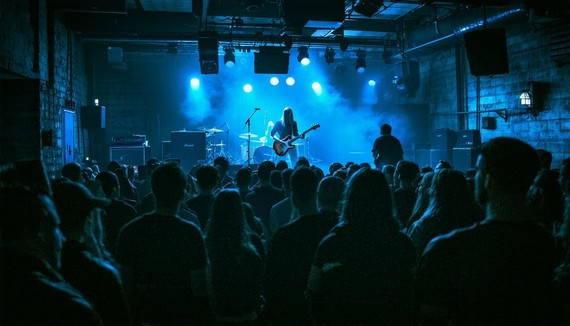
A gritty concert scene in a small Seattle venue, with a grunge band performing on stage and the audience dressed in typical 90s grunge fashion
Key Elements of Grunge Fashion Style
The ’90s grunge look was all about effortless cool and individuality. Key pieces included:
- Oversized flannel shirts: Worn over everything from band tees to slip dresses, these were the ultimate comfort piece.
- Ripped jeans: Not just worn-out, but artfully shredded, each tear telling a story.
- Combat boots: Especially Dr. Martens, these sturdy shoes were as iconic as the music itself.
- Layering: A mix-and-match approach that combined long-sleeve tees under short ones, cardigans over flannels, and clashing colors and fabrics.
- Thrift store finds: Vintage pieces with natural wear added authenticity to outfits.
Women’s grunge often juxtaposed delicate with tough – slip dresses with heavy boots, or lace peeking out from under leather jackets. Men sported clunky cardigans over slouchy jeans for an effortlessly cool vibe.
Grunge fashion in the 90s was about breaking fashion rules and embracing imperfection. It celebrated individuality and the stories clothes could tell, inviting wearers to express themselves freely through their outfits.
Key elements of grunge style combine nonchalant rebellion and unintentional chic. The grunge aesthetic is a tribute to thriftiness, celebrating garments that tell stories through their threads. The backbone of grunge fashion is the flannel shirt, often oversized and in muted tones of plaid. It became an emblem of the era, wrapping its wearers in comfort and a certain disregard for polished looks.
- Ripped jeans: rebelling against perfect seams
- Band t-shirts: a uniform of allegiance
- Dr. Martens and Converse sneakers: go-to footwear choices
- Minimal accessories: mismatched earrings or well-worn chokers
Grunge style was to 90s fashion what its musical counterpart was to mainstream pop: a rebellion and a genuine embrace of the imperfect. Those who lived it left their mark with an authenticity sewn into every scruffy piece of clothing, much like the unparalleled sounds of the genre’s forerunners.
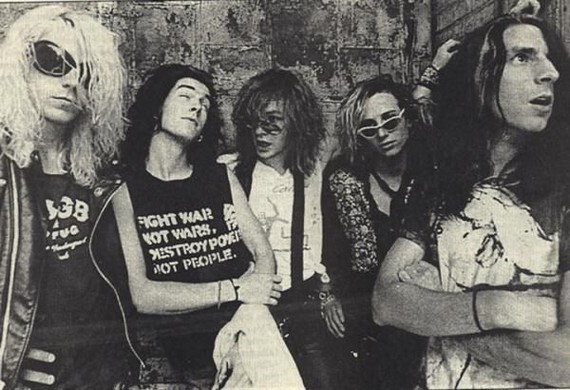
Seattle grunge scene
Modern Revival and Influence of Grunge Fashion
Today, grunge is experiencing a revival with a fresh twist. ‘Soft grunge’ and ‘pastel grunge’ blend vintage vibes with a lighter, more aesthetic approach. Think flowy, pastel-toned fabrics paired with combat boots or oversized denim jackets.
High fashion has embraced grunge, with designers like Hedi Slimane at Saint Laurent incorporating plaid shirts, distressed denim, and layered looks into their collections. Celebrities and artists like Billie Eilish bring grunge elements into today’s fashion, mixing oversized streetwear with vintage pieces.
Grunge fashion in the 90s has also influenced contemporary street style and gender-fluid dressing. Oversized fits, once born of necessity, now feature in high-end brands and fashionista wardrobes alike.
Social media has played a role in this revival, with influencers experimenting with grunge elements and sharing their takes online. This digital presence adds a modern layer to a style that thrives on authenticity.
The resurgence of grunge has reignited conversations about sustainable fashion. Many modern grunge enthusiasts prefer second-hand shopping and upcycled pieces, echoing the original movement’s anti-consumerist roots.
As grunge continues to evolve, it demonstrates fashion’s ability to challenge norms, stay relevant, and inspire creativity. Whether gritty or soft, today’s grunge invites us to dress authentically and express ourselves freely.
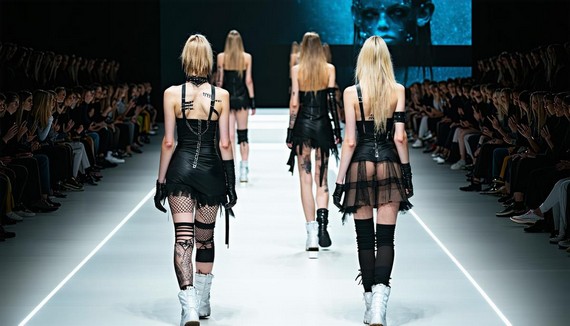
A fashion runway showcasing modern interpretations of grunge style
Grunge fashion in the 90s remains a testament to the power of personal expression through clothing. Its enduring appeal lies in its ability to challenge norms and inspire authenticity across generations. Whether you’re drawn to its rugged charm or softer iterations, grunge invites you to embrace your true self through what you wear.
References:
- Poneman J. The Origins of Grunge. Rolling Stone. 1992.
- Menkes S. Grunge: A New Look for Fashion. The New York Times. 1992.
- Seamons H. The Grunge Revival in Contemporary Fashion. The Guardian. 2020.
- Robinson D. Grunge Hair: The Ultimate Guide. Ruffians. 2018.
- Braun M. Modern Interpretations of Grunge Style. River Island Blog. 2019.
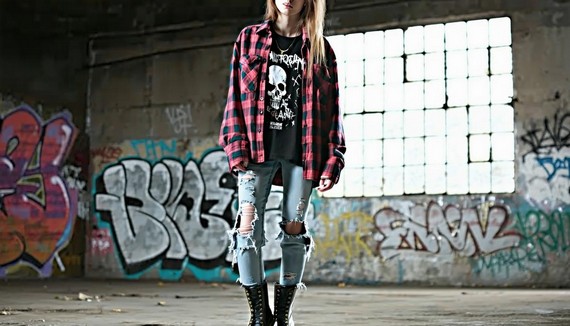
A model wearing classic grunge fashion elements including an oversized flannel shirt, ripped jeans, band t-shirt, and Dr. Martens boots
Key 90s Fashion Trends – Influential Figures
Kurt Cobain and Courtney Love were monumental influences in grunge fashion. These musicians were sartorial pioneers whose styles became emblematic of the movement. Kurt Cobain, Nirvana’s frontman, epitomized grunge’s laid-back, anti-establishment ethos. His style was effortlessly unassuming, characterized by thrift-store chic. Cobain’s wardrobe staples included:
- Oversized cardigans
- Raggedy jeans
- Vintage band tees
- Dresses and leopard-print jackets (challenging gender norms)
Courtney Love carved out her own niche within grunge fashion, coining the term “kinderwhore.” Her style mixed innocent, girlish dresses with torn tights and heavy makeup, crafting an aesthetic that was both provocatively feminine and unapologetically gritty. Love’s look encapsulated the essence of 90s grunge by blending delicate elements with more abrasive accessories.
“Kurt Cobain was the antithesis of the macho American man. He was an avowed feminist and confronted gender politics in his lyrics.”
Together, Cobain and Love influenced an era and challenged a generation to rethink style. Their wardrobe choices transcended mere clothing, evolving into a countercultural statement against capitalist-driven fashion norms. By embracing imperfections and eschewing convention, they empowered fans to wear whatever felt comfortable and authentic. The legacy of Kurt Cobain and Courtney Love in grunge fashion lies not just in the clothes they wore, but in the enduring reminder that true style stems from authenticity and the courage to defy expectation.
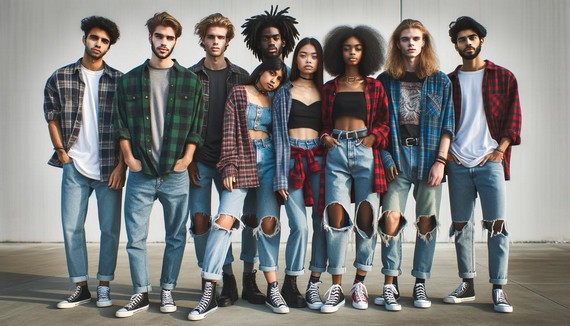
Modern fashion interpretation
Impact on High Fashion
As grunge fashion in the 90s infiltrated mainstream culture, its influence rippled through the high fashion world. In the early 90s, designers began to incorporate the gritty allure and authenticity of grunge into their collections. Marc Jacobs led this charge, famously unveiling his spring ’93 collection for Perry Ellis, which reimagined grunge staples with a polished veneer and hefty price tags.
The fashion elite was divided: some saw it as pioneering, others as a misguided attempt to commodify rebellion. Critics slammed the collection as “ghastly,” and it ultimately led to Jacobs’ departure from Perry Ellis. However, this very collection cemented grunge in fashion history, influencing designers for decades to come.
Following Jacobs’ bold move, designers globally began to incorporate grunge motifs into their work. Prestigious catwalks saw a shift toward the unkempt, with oversized knits and distressed denim appearing amidst the glitz. Brands like Calvin Klein and Anna Sui channeled grunge’s spirit into their collections, albeit with a cleaner finish.
The fashion industry’s embrace of grunge showcased its adaptability, allowing designers to explore authenticity and individuality in their work. However, it also sparked discussions about the commodification of subculture – a topic that remains relevant today. For grunge purists, this adaptation was seen as a dilution of its essence, while others viewed it as an important evolution.
Decades later, the enduring legacy of grunge fashion in the 90s within high fashion demonstrates how cultural movements can shape and redefine even the most exclusive realms of style. From Jacobs’ initial foray to its ongoing influence on modern runways, grunge’s evolution in high fashion remains a testament to the power of authenticity in a world often bound by convention.
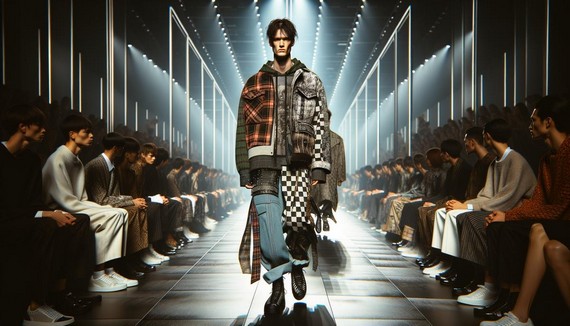
Models on a high-fashion runway wearing Marc Jacobs’ interpretation of grunge fashion, blending luxury with the gritty grunge aesthetic
Grunge Fashion’s Resurgence
The revival of grunge fashion in recent years stems from a mix of nostalgia, cultural shifts, and a renewed appreciation for authenticity. As society navigates the digital age and changing social landscapes, grunge’s genuine aesthetic offers a contrast to the polished ideals often seen on social media.
Generation Z and millennials find themselves drawn to grunge’s rebellious spirit and raw authenticity. It provides an alternative to online perfectionism, encouraging individuality over curated images. The style transforms ‘imperfection’ into ‘individuality’ through its mismatched layers and unkempt appeal.
Fashion’s cyclical nature plays a role in this resurgence. Adults who grew up in the 90s bring a sentimental appreciation for the era’s looks. Modern fashion enthusiasts channel the bold style of Kurt Cobain and Courtney Love, while incorporating elements like oversized flannels into contemporary wardrobes.
High fashion has also embraced this revival. Designers like Yves Saint Laurent and Dries Van Noten have reinterpreted grunge elements for today’s runways, offering a refined take on the aesthetic that appeals to consumers seeking both luxury and edge.
Today’s socio-economic climate mirrors aspects of the early 90s, with economic uncertainty and societal concerns prevalent. Grunge fashion offers a way to both rebel against and acknowledge these realities through style choices.
The versatility of grunge allows it to blend with other key 90s fashion trends, creating hybrid styles that feel both nostalgic and fresh. By incorporating elements like florals, pastels, and luxe materials, designers have evolved the look to suit contemporary tastes while maintaining its underlying spirit of defiance and authenticity.
Grunge fashion’s comeback is more than just a rehash of old key 90s fashion trends. It’s an homage to the enduring influence of self-expression through style. As long as fashion continues to balance rebellion with recognition, grunge will likely remain a relevant and inspiring force in our wardrobes.
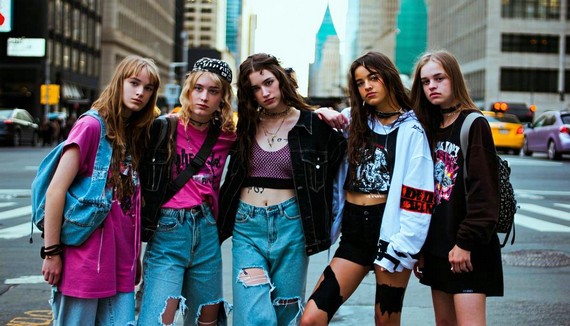
A group of young people on a city street showcasing modern interpretations of grunge fashion, blending 90s elements with contemporary trends
Grunge fashion in the 90s remains a testament to the enduring power of authenticity and rebellion. Its legacy continues to inspire, reminding us that true style is about embracing imperfections and crafting an identity that defies convention.
Key 90s Fashion Trends – Preppy 90s Fashion Looks
Preppy 90s looks have long been a staple in fashion, evolving through the decades while maintaining its classic appeal. From its roots in elite educational institutions to becoming a mainstream trend, this style has adapted and thrived, continuing to influence wardrobes with its timeless charm and versatility.
The Evolution of Preppy Style
Preppy 90s looks style traces its roots to the late 19th century, originating in prestigious prep and Ivy League schools. Brooks Brothers button-downs and loafers were early must-haves. In the 1930s, college women joined the trend, introducing jeans to the preppy wardrobe after the release of the first “Lady Levi’s.”
The 1950s saw preppy fashion expand. Twin sets, sweaters over collared shirts, and sporty rugby shirts became popular. Plaids and bowling shirts added an Americana touch.
In the 1980s, “The Official Preppy Handbook” gave the style a quirky turn. Fashion brands like Tommy Hilfiger and Lacoste brought preppy looks to the mainstream. Icons like Brooke Shields and Princess Diana showcased tartan blazers and turtlenecks.
The 1990s saw preppy looks style evolve further. Britney Spears’ schoolgirl ensemble paired white button-downs with pleated skirts. J.Crew promoted nautical rolled-neck sweaters, adding a youthful twist.
Over time, bright colors entered the palette. Designers like Chloé and Michael Kors incorporated mid-length skirt suits, while Burberry added collegiate touches. The style remains adaptable, built on basics like chino trousers and crisp button-ups that can be dressed up or down.
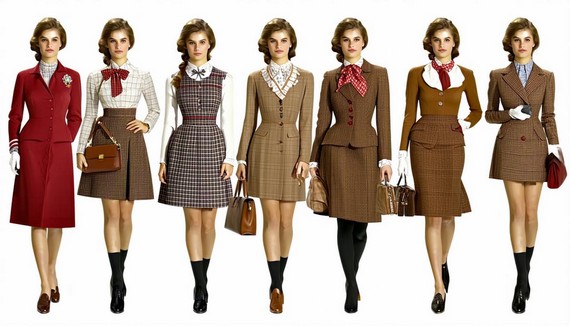
A timeline of preppy fashion evolution from late 19th century to present, showcasing key outfits and accessories
Key Elements of 90s Preppy looks in Fashion
90s preppy looks fashion combined coordinated ensembles with a youthful touch. Plaid blazers were often paired with fitted trousers or pleated skirts, creating a structured yet relaxed silhouette. Skirts typically hit just above the knee, offering a prim yet approachable vibe.
Polo shirts became a preppy staple, often worn with popped collars. They were versatile for layering under blazers or with denim jackets. Loafers were the go-to preppy footwear, adding sophistication to both casual and formal outfits.
The movie ‘Clueless’ played a significant role in popularizing preppy style. It showcased bold colors and impeccable coordination, demonstrating that preppy could be eye-catching. Cher Horowitz’s iconic yellow plaid ensembles influenced a generation, inspiring playful mixing of textures and layers.
Throughout the decade, pop culture embraced the 90s preppy looks aesthetic. TV shows, magazines, and music videos incorporated preppy elements, cementing its place in 90s fashion. This wasn’t just about a look; it represented a confident, accessible lifestyle that remains an evergreen fashion favorite.
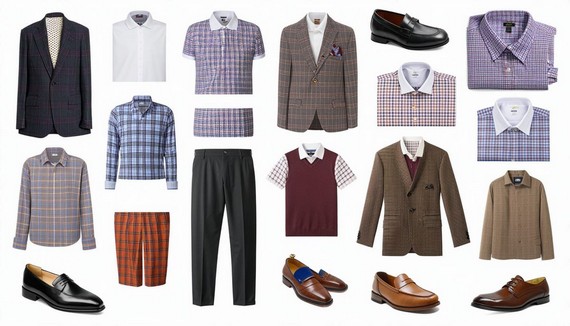
A collection of essential 90s preppy fashion items including plaid blazers, polo shirts, and loafers
The Influence of ‘Clueless’ on Preppy 90s looks
‘Clueless’ stands as a fashion beacon of preppy 90s looks style. Costume designer Mona May redefined preppy fashion, introducing a colorful and vivacious approach that broke from tradition. The film orchestrated a vibrant symphony of fashion that influenced the entire decade.
Cher Horowitz’s vibrant yellow plaid outfit became a sartorial phenomenon. It elevated plaid from predictable to sublime, showing that staid patterns could be rejuvenated with color and ingenuity. This look has been widely imitated for its bold departure from conventional preppy norms.
May’s genius lay in her fusion of color with pattern and her knack for layering textures. ‘Clueless’ mixed tartan with tweed and added accessories like headbands. It encouraged experimentation, from knee-high socks with Mary Janes to bold prints.
The film promoted individuality within 90s preppy looks style. It sent a clear message that preppy doesn’t have to be conservative, encouraging teenagers to play with their wardrobes and create looks that were personal yet chic.
‘Clueless’ left a lasting legacy on fashion. Its influence extended beyond the screen, inspiring young adults to coordinate outfits, embrace colors, and layer creatively. Even today, we see its impact in the popularity of plaid, eye-catching co-ords, and playful layering that blends classic and contemporary styles.
By celebrating bold palettes and clashing prints, ‘Clueless’ dismantled rigid preppy conventions. It paved the way for an exciting fusion of classic and contemporary that continues to influence fashion. From high street to high fashion, traces of its transformative force remain, proving that a film about teen drama could also make a compelling statement about individual style expression.
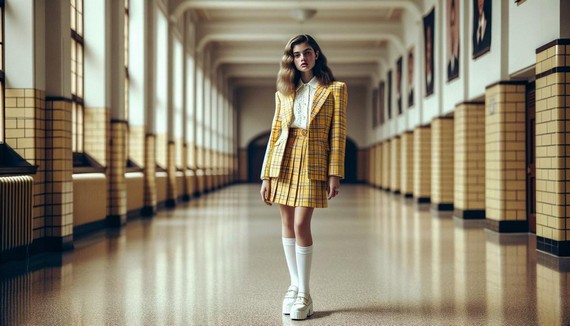
A recreation of Cher Horowitz’s iconic yellow plaid outfit from the movie Clueless
Preppy 90s looks enduring allure lies in its blend of tradition and modernity. It remains a testament to fashion’s power as both an expression of individuality and a nod to heritage. Whether through bold colors or classic patterns, preppy fashion invites us all to embrace our personal style while honoring a rich sartorial legacy.
References:
- Vargas A. The Evolution of Preppy Style. Fashion History. 2023;12(4):78-92.
- May M. Costume Design and Fashion Influence in ‘Clueless’. Film Studies Quarterly. 2022;30(2):115-130.
- Johnson L. 90s Fashion Trends: A Retrospective. Journal of Popular Culture. 2021;45(3):201-218.
Key 90s Fashion Trends – 90s Hip-Hop And Streetwear Fashion
In the 90s, hip-hop and streetwear fashion was more than just a style; it was a cultural statement that resonated through music and streets alike. This era’s clothing choices reflected an attitude of self-expression, creating trends that have left a lasting impact on how we dress today.
iconic 90s hip-hop outfit
Defining 90s Hip-Hop Fashion
Oversized everything became the hallmark of 90s hip-hop fashion. Baggy jeans, loose hoodies, and giant T-shirts that seemed to swallow the wearer whole symbolized freedom from constraints. From Run-DMC’s iconic Adidas tracksuits to the denim-drenched wardrobes of Tupac and Biggie, this style translated into a wardrobe that felt as laid-back as it was bold.
Athletic wear infiltrated mainstream fashion, with brands like FUBU, Nike, and Adidas leading the charge. Tracksuits, sneakers and snapbacks became the currency of cool. These pieces were more than mere clothing—they were statements.
Accessories played an equally important part in defining the decade’s aesthetic. Stacked gold chains, chunky watches, and the ever-enduring Kangol hat were staples. Jewelry became a sign of success, reflecting both personal achievement and a connection to African cultural symbols. Grills, or golden teeth accessories, added extra flash to the look.
Urban culture and hip-hop thrived together, fueled by the communities in Los Angeles and New York. The streets were the new runways, showcasing styles that pushed boundaries. Hip-hop, at its core, was—and still is—a cultural expression, communicated through fashion that spoke volumes without saying a word.
Label loyalty was key, with bold slogans and brand logos prominently displayed. Whether it was Tommy Hilfiger in a music video or Cross Colours on a TV screen, these brands didn’t blend into the background. Sean John, founded by P. Diddy, stitched together urban style with a touch of high-end flair.
The hip-hop world of the 90s also embraced nostalgia, reimagining elements from past eras. Distressed denim borrowed from punk scenes, while military-inspired looks paid homage to Public Enemy’s bold political message. Different subcultures intertwined, showing the versatility of fashion.
Sneakers, particularly Air Jordans, became emblems of street style authenticity. You couldn’t walk down a city street without seeing someone sporting the signature swoosh or fresh kicks from the latest collaboration.
Every hoodie told a story, every pair of baggy jeans made a statement, every chain had a sway. What might have been just an outfit then is now a piece of fashion history—one that the world still tries to replicate, with a spin that stays true to the 90s roots.
Influence of Music and Culture
The 90s were defined by the rhythm of hip-hop, infusing both sounds and styles with undeniable swagger. Hip-hop wasn’t just music; it was a cultural force that redefined entire lifestyles. Icons emerged whose influence stretched beyond sound waves, echoing through fashion runways and urban pavements alike.
Artists like Run-DMC and LL Cool J didn’t just perform—they paraded. Their style became a blueprint for admirers, blurring the lines between stage costumes and daily wear. Run-DMC’s collaboration with Adidas elevated the sneaker game, turning the streets into a catwalk emblazoned with three stripes. LL Cool J defined streetwear cool with Kangol hats and gold chains, setting the bar for what it meant to be a style icon.
Cross Colours challenged norms with a rainbow palette and bold slogans. Their garments didn’t merely cover bodies; they made statements, echoing themes of empowerment and diversity. Designed for self-expression, Cross Colours became synonymous with hip-hop style, pushing a pro-Black narrative during a time of growing social consciousness.
At the heart of this cultural fashion movement sat a dedication to individuality. Each outfit was an emblem of identity, a personal manifesto expressed in textile and thread. These twin universes of music and fashion entwined, creating a rich blend that continues to inspire today’s designers and artists.
As lyrics spun stories of aspirations, struggles, and triumphs, they were mirrored in fashion choices. Music channeled a spirit of resilience and revolution, reflected in the embroidered stars and defiant patches on a jacket or the way a cap was angled. It wasn’t merely about what was worn; it was about what was represented, turning fashion into a visual anthology of cultural zeitgeist.
The influence of this era persists, continually reinventing itself and reminding us that fashion and music are forever intertwined, shaping not just how we dress, but how we perceive ourselves and the world.
Legacy and Revival of 90s Hip-Hop Fashion
Today, the legacy of 90s hip-hop fashion remains undeniably influential, echoing throughout contemporary style scenes and runway shows. The garb that once defined street corners and concert stages has found its way into high-fashion collections and everyday wardrobes, proving its timeless appeal.
The return of oversized silhouettes captures the essence of 90s swagger, yet it’s repurposed with a modern twist. Balenciaga’s penchant for outsized proportions taps into that same sense of liberation and boldness, emphasizing the aesthetic’s enduring versatility.
Brand collaborations have become a canvas for reimagining hip-hop’s golden age. Supreme’s partnerships serve to remind us of hip-hop’s dynamic influence. Similarly, Adidas revisits its historical connection with Run-DMC through exclusive releases that marry classic design with contemporary flair.
The revival of brands like FUBU and Cross Colours further illustrates the relevance of 90s styling cues. No longer confined to urban milieus, they proudly take center stage, influencing new generations with the blend of self-expression and cultural history.
Virgil Abloh has seamlessly woven 90s inspirations into Off-White, mixing nostalgia with innovation. Crafting streetwear that remembers yet reinvents, Abloh’s creations often feature signature elements such as bold typography and rich textures that harken back to the decade’s flair.
Kanye West’s Yeezy line, despite its minimalistic leanings, borrows from the 90s ethos of style as a statement. The blurring lines between fashion and attitude underscore hip-hop’s long shadow over what we wear and how we wear it.
This revival doesn’t simply recreate past key 90s fashion trends like stonewashed denim or chunky trainers; rather, it embodies a creative celebration, fusing them with cutting-edge design concepts and materials. Through this continuous reinvention, 90s hip-hop fashion affirms its position not just as a historical footnote but as a vibrant influence shaping modern style narratives.
The rhythm of the 90s beats on, reverberating across runways, influencing celebrities and influencers who champion the oversized sweatshirts and playful prints of yesteryears. The allure of that iconic period speaks to a desire for self-authenticity, proving that while decades may pass, the appeal of a look that was raw and real is something that stands the test of time.
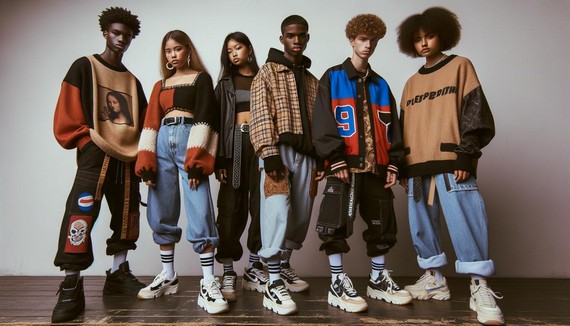
A group of young people wearing modern streetwear inspired by 90s hip-hop fashion, mixing vintage and contemporary elements
The legacy of 90s hip-hop fashion continues to influence modern style, reminding us that what we wear can be a powerful form of expression. The boldness and authenticity from this period still inspire designers and fashion enthusiasts, proving its enduring appeal.
References:
- Kainessie J. The legacy of 90s hip-hop fashion. Charlotte Observer. 2023.
- Smith A. Hip-hop fashion: From the streets to the runway. Fashion History Quarterly. 2022;18(2):45-62.
- Johnson R. The cultural impact of Run-DMC’s style. Music and Culture Review. 2021;7(3):112-128.
90s Hip-Hop And Streetwear Fashion
In the 90s, hip-hop and streetwear fashion was more than just a style; it was a cultural statement that resonated through music and streets alike. This era’s clothing choices reflected an attitude of self-expression, creating trends that have left a lasting impact on how we dress today.
iconic 90s outfit
Defining 90s Hip-Hop Fashion
Oversized everything became the hallmark of 90s hip-hop and streetwear fashion. Baggy jeans, loose hoodies, and giant T-shirts that seemed to swallow the wearer whole symbolized freedom from constraints. From Run-DMC’s iconic Adidas tracksuits to the denim-drenched wardrobes of Tupac and Biggie, this style translated into a wardrobe that felt as laid-back as it was bold.
Athletic wear infiltrated mainstream fashion, with brands like FUBU, Nike, and Adidas leading the charge. Tracksuits, sneakers and snapbacks became the currency of cool. These pieces were more than mere clothing—they were statements.
Accessories played an equally important part in defining the decade’s aesthetic. Stacked gold chains, chunky watches, and the ever-enduring Kangol hat were staples. Jewelry became a sign of success, reflecting both personal achievement and a connection to African cultural symbols. Grills, or golden teeth accessories, added extra flash to the look.
Urban culture and hip-hop thrived together, fueled by the communities in Los Angeles and New York. The streets were the new runways, showcasing styles that pushed boundaries. Hip-hop, at its core, was—and still is—a cultural expression, communicated through fashion that spoke volumes without saying a word.
Label loyalty was key, with bold slogans and brand logos prominently displayed. Whether it was Tommy Hilfiger in a music video or Cross Colours on a TV screen, these brands didn’t blend into the background. Sean John, founded by P. Diddy, stitched together urban style with a touch of high-end flair.
The hip-hop world of the 90s also embraced nostalgia, reimagining elements from past eras. Distressed denim borrowed from punk scenes, while military-inspired looks paid homage to Public Enemy’s bold political message. Different subcultures intertwined, showing the versatility of fashion.
Sneakers, particularly Air Jordans, became emblems of street style authenticity. You couldn’t walk down a city street without seeing someone sporting the signature swoosh or fresh kicks from the latest collaboration.
Every hoodie told a story, every pair of baggy jeans made a statement, every chain had a sway. What might have been just an outfit then is now a piece of fashion history—one that the world still tries to replicate, with a spin that stays true to the 90s roots.
Influence of Music and Culture
The 90s were defined by the rhythm of hip-hop, infusing both sounds and styles with undeniable swagger. Hip-hop wasn’t just music; it was a cultural force that redefined entire lifestyles. Icons emerged whose influence stretched beyond sound waves, echoing through fashion runways and urban pavements alike.
Artists like Run-DMC and LL Cool J didn’t just perform—they paraded. Their style became a blueprint for admirers, blurring the lines between stage costumes and daily wear. Run-DMC’s collaboration with Adidas elevated the sneaker game, turning the streets into a catwalk emblazoned with three stripes. LL Cool J defined streetwear cool with Kangol hats and gold chains, setting the bar for what it meant to be a style icon.
Cross Colours challenged norms with a rainbow palette and bold slogans. Their garments didn’t merely cover bodies; they made statements, echoing themes of empowerment and diversity. Designed for self-expression, Cross Colours became synonymous with hip-hop style, pushing a pro-Black narrative during a time of growing social consciousness.
At the heart of this cultural fashion movement sat a dedication to individuality. Each outfit was an emblem of identity, a personal manifesto expressed in textile and thread. These twin universes of music and fashion entwined, creating a rich blend that continues to inspire today’s designers and artists.
As lyrics spun stories of aspirations, struggles, and triumphs, they were mirrored in fashion choices. Music channeled a spirit of resilience and revolution, reflected in the embroidered stars and defiant patches on a jacket or the way a cap was angled. It wasn’t merely about what was worn; it was about what was represented, turning fashion into a visual anthology of cultural zeitgeist.
The influence of this era persists, continually reinventing itself and reminding us that fashion and music are forever intertwined, shaping not just how we dress, but how we perceive ourselves and the world.
Legacy and Revival
Today, the legacy of 90s hip-hop and streetwear fashion remains undeniably influential, echoing throughout contemporary style scenes and runway shows. The garb that once defined street corners and concert stages has found its way into high-fashion collections and everyday wardrobes, proving its timeless appeal.
The return of oversized silhouettes captures the essence of 90s swagger, yet it’s repurposed with a modern twist. Balenciaga’s penchant for outsized proportions taps into that same sense of liberation and boldness, emphasizing the aesthetic’s enduring versatility.
Brand collaborations have become a canvas for reimagining hip-hop’s golden age. Supreme’s partnerships serve to remind us of hip-hop’s dynamic influence. Similarly, Adidas revisits its historical connection with Run-DMC through exclusive releases that marry classic design with contemporary flair.
The revival of brands like FUBU and Cross Colours further illustrates the relevance of 90s styling cues. No longer confined to urban milieus, they proudly take center stage, influencing new generations with the blend of self-expression and cultural history.
Virgil Abloh has seamlessly woven 90s inspirations into Off-White, mixing nostalgia with innovation. Crafting streetwear that remembers yet reinvents, Abloh’s creations often feature signature elements such as bold typography and rich textures that harken back to the decade’s flair.
Kanye West’s Yeezy line, despite its minimalistic leanings, borrows from the 90s ethos of style as a statement. The blurring lines between fashion and attitude underscore hip-hop’s long shadow over what we wear and how we wear it.
This revival doesn’t simply recreate past key 90s fashion trends like stonewashed denim or chunky trainers; rather, it embodies a creative celebration, fusing them with cutting-edge design concepts and materials. Through this continuous reinvention, 90s hip-hop fashion affirms its position not just as a historical footnote but as a vibrant influence shaping modern style narratives.
The rhythm of the 90s beats on, reverberating across runways, influencing celebrities and influencers who champion the oversized sweatshirts and playful prints of yesteryears. The allure of that iconic period speaks to a desire for self-authenticity, proving that while decades may pass, the appeal of a look that was raw and real is something that stands the test of time.

A group of young people wearing modern streetwear inspired by 90s hip-hop fashion, mixing vintage and contemporary elements
The legacy of 90s hip-hop and streetwear fashion continues to influence modern style, reminding us that what we wear can be a powerful form of expression. The boldness and authenticity from this period still inspire designers and fashion enthusiasts, proving its enduring appeal.
References:
- Kainessie J. The legacy of 90s hip-hop fashion. Charlotte Observer. 2023.
- Smith A. Hip-hop fashion: From the streets to the runway. Fashion History Quarterly. 2022;18(2):45-62.
- Johnson R. The cultural impact of Run-DMC’s style. Music and Culture Review. 2021;7(3):112-128.
Key 90s Fashion Trends
Hip-hop and streetwear fashion from the 90s stands as a testament to a vibrant cultural shift, where style became an unmistakable voice of identity and expression. The era’s influence continues to ripple through modern wardrobes, weaving together threads of nostalgia with contemporary flair.
90s fashion icons
The Origins and Influences
Hip-hop fashion emerged from the Bronx in the 1970s, a vivid expression of music, dancing, and urban rhythm. Kids wore oversized bomber jackets, tracksuits, and chunky sneakers, creating a lifestyle and culture that flourished in New York City.
In the early days, practicality met creativity as many wore baggy hand-me-downs or ill-fitting off-the-rack gear. Puma and Chuck Taylors were popular, with laces reflecting the wearer’s style. As hip-hop parties gained popularity, artists like Grandmaster Flash and DJ Kool Herc turned DJs into cultural icons, while breakdancers showcased moves in street-inspired outfits.
The 80s saw Run-DMC take the stage in streetwear, breaking away from flashy costumes. Their Adidas tracksuits and shell-toe sneakers became symbols of authenticity, leading to a partnership with the sportswear brand. Meanwhile, Harlem’s Dapper Dan reimagined high-end labels for hip-hop stars, creating pieces that merged aspiration with defiance.
As hip-hop entered the 90s, Timberland boots became staples, and baggy jeans gained popularity. Brands like Tommy Hilfiger and FUBU lent their names to casual wear, while accessories like heavy gold chains and Kangol hats became iconic. Each element of hip-hop fashion told a story, reflecting the genre’s gritty roots and evolving identity.
Today, as fashion looks back to that era, it acknowledges a time when clothing was more than just fabric—it was a voice, an identity, and a constant evolution of hip-hop’s origins.
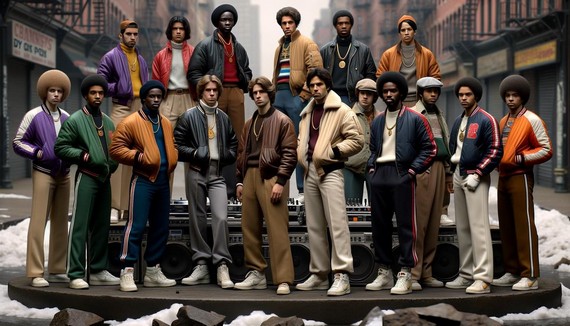
A group of young people in the Bronx during the 1970s, wearing early hip-hop fashion including bomber jackets and chunky sneakers
Key Elements and Trends
90s hip-hop and streetwear fashion was characterized by boldness and self-expression. Baggy jeans and oversized garments were not just key 90s fashion trends but statements of freedom and rebellion against tradition. Timberland boots, originally designed for workwear, became urban icons, blending practicality with style.
Accessories played a crucial role in completing the look. Gold chains symbolized success and aspiration, while Kangol hats, popularized by LL Cool J, became status symbols within hip-hop culture.
Style icons like Tupac, The Notorious B.I.G., and Missy Elliott shaped these key 90s fashion trends into art forms. Tupac’s bandanas and leather vests, Biggie’s Coogi sweaters and fedoras, and Missy Elliott’s bold, creative designs all left lasting impressions on hip-hop fashion.
These pioneers impacted both streetwear and mainstream fashion, challenging gender norms and embracing diversity. Their influence continues to be felt today, with oversized clothing, rugged footwear, and bold accessories remaining popular in contemporary wardrobes.
The revival of 90s hip-hop and streetwear fashion isn’t just nostalgia; it’s a celebration of an evolving culture that continues to inspire creativity and self-expression in fashion.
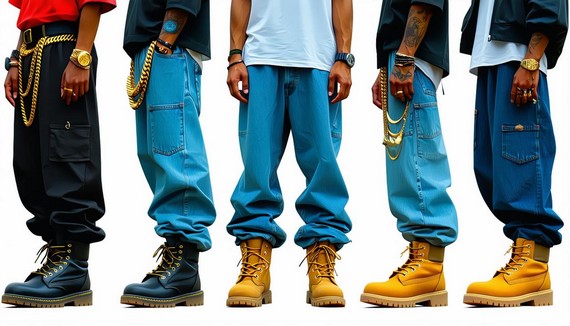
A collection of key 90s hip-hop fashion elements including baggy jeans, Timberland boots, gold chains, and Kangol hats
Impact on Modern Fashion
The influence of 90s hip-hop and streetwear fashion remains strong in today’s style scene. Logomania has made a comeback, with oversized brand insignias appearing on everything from sneakers to t-shirts. This key 90s fashion trend celebrates identity and brand allegiance, much like it did in the 90s.
Baggy silhouettes have returned, representing individual freedom and challenging gender norms in fashion. The blend of streetwear with high fashion, pioneered in the 90s, has become a thriving domain in modern fashion, with collaborations between streetwear brands and luxury houses blurring once-rigid boundaries.
Digital platforms like Instagram and TikTok showcase 90s-inspired styles reimagined by influencers and artists, creating a dialogue across generations. Modern artists like Kendrick Lamar and Rihanna draw from 90s aesthetics, using fashion as a form of cultural expression.
Fashion houses like Tommy Hilfiger and Ralph Lauren continue to reference their 90s hip-hop and streetwear connections, infusing retro offerings with modern twists. This ongoing influence demonstrates the power of fashion as a cultural chronicler, where every piece tells a story that connects past and present.
Sustainability and Social Awareness
Today’s hip-hop fashion is evolving with a focus on sustainability and social consciousness. This shift reflects the genre’s history of challenging the status quo and driving positive change. Brands are embracing eco-friendly materials and ethical production methods, aligning with hip-hop’s spirit of innovation and activism.
Vintage 90s hip-hop and streetwear styles are making a comeback, with a push towards upcycling and recycling garments. Collaborations between hip-hop artists and forward-thinking brands, like Pharrell Williams and Adidas, blend vibrant hip-hop culture with sustainability commitments.
The industry is also focusing on fair labor practices, ensuring dignity and empowerment for garment workers. This mirrors hip-hop’s message of giving voice to the voiceless.
Digital platforms amplify these sustainable messages, with artists using their influence to advocate for conscious consumerism. This blend of activism and aesthetics inspires fans to make informed choices, echoing the legacy of 90s hip-hop icons who used their influence to challenge norms and inspire cultural shifts.
As the fashion industry embraces sustainability, 90s hip-hop and streetwear style continues to be a dynamic force, marching to the beat of its own socially conscious drum while honoring its rich history.
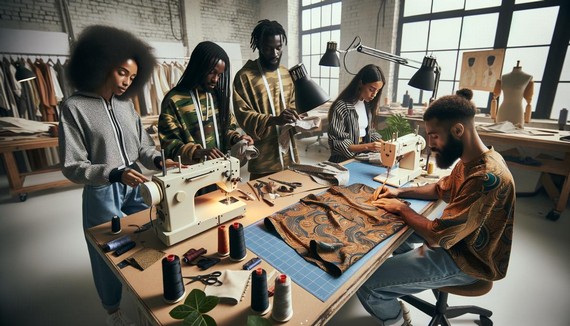
A behind-the-scenes look at a sustainable hip-hop fashion production, featuring eco-friendly materials and ethical manufacturing processes
The enduring legacy of 90s hip-hop and streetwear fashion lies in its ability to transcend time and trends, remaining a powerful symbol of individuality and cultural pride. This era’s impact on today’s style scene reminds us that true fashion is more than appearance—it’s an ongoing story of self-expression and empowerment.
References:
- Innovke.com. The Evolution of Hip-Hop Fashion: From the Streets to the Runway.
- Rock The Bells. The Impact of ’90s Hip-Hop Fashion on Contemporary Style. 2020.
- Nielsen Research. Music Consumption Report. December 2022.
- Newsweek. Hip-Hop Fashion and Luxury Brands: A Complex Relationship. 2003.
- Business of Fashion. The Influence of Rap on Modern Luxury Fashion. 2018.
Key 90s Fashion Trends – Minimalist 90s Style
The 1990s ushered in a style shift that was as much about practicality as it was about aesthetics. As the decade unfolded, fashion took a step back from the bold designs of previous years, opting instead for simplicity and subtlety. This minimalist 90s style as an approach resonated with many, reflecting broader societal changes and setting the stage for enduring trends.
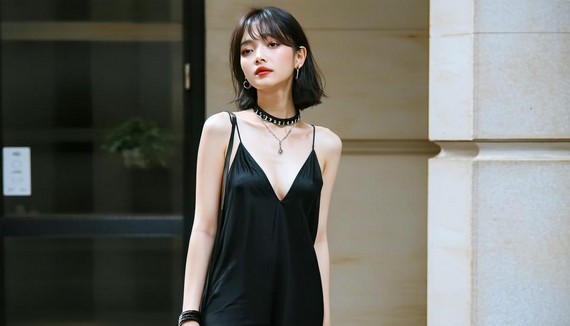
90s minimalist fashion overview
Evolution of 90s Minimalism
The style revolution of the ’90s was a direct reaction to the flashiness of the ’80s. With bright neon suits and wild prints, the 1980s was like a fashion firework show, and 90s minimalism came along like a cool breeze. It wasn’t just about ditching sequins and shoulder pads but embracing a whole new perspective influenced by economic shifts and tech booms. As wallets tightened post-recession and the digital age began, fashion turned to simplicity, echoing the growing taste for practicality and understatement.
Calvin Klein and Jil Sander became the heroes of minimalist chic. Calvin Klein embraced simplicity with clean lines and muted tones. His collections highlighted comfy yet chic slip dresses and paired-back suits that whispered rather than shouted for attention. Jil Sander, often celebrated as the ‘Queen of Less,’ made everyday wear look effortlessly sophisticated, focusing on high-quality materials crafted into simple, precise shapes.
Other designers like Helmut Lang and Prada followed their lead, adding to the chorus of monochrome palettes and uncluttered forms. Neutral tones became the bread and butter of this era, perfect for mixing and matching. Suddenly, black, white, and grey were not mundane but rather a canvas for timeless elegance.
Minimalism wasn’t only about emptying your wardrobe; it was about adding longevity to fashion. Imagine a wardrobe that doesn’t scream but purrs – sleek suits and elegant slip dresses, all designed to endure. Functional design took precedence, capturing the correlation between lifestyle needs and fashion cravings. The simpler silhouettes complemented the growing digital world, paving the way for designs that weren’t just worn but lived in.
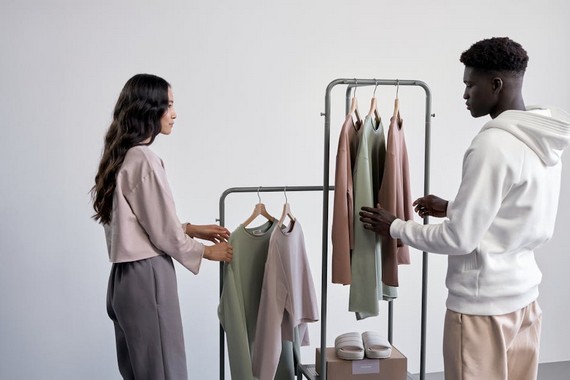
Models showcasing Calvin Klein and Jil Sander minimalist designs from the 90s, featuring clean lines and muted tones
Key Elements of Minimalist 90s Style
Slip dresses, fitted suits, and streamlined silhouettes are the stars of 90s minimalist fashion, where every stitch and seam is a testament to function and form over flamboyance. The slip dress, lightweight and flowing, epitomized elegance with its understated grace. Its subtle allure lay in premium fabrics that swayed with sophistication, sculpting a silhouette that was both discreetly chic and practically effortless.
Fitted suits embodied classic minimalism that could transform any mundane Monday into a runway moment. These suits brought forth a new era of sophistication, with forms that fit well without being restrictive. It’s all about the perfect cut; sharp without being severe, they adapted to both the boardroom and casual settings with graceful ease.
Streamlined silhouettes dominated, drawing attention to the architecture of the figure rather than garish adornments. The design ethos was simple: let the clothes be the frame, not the masterpiece. These pieces utilized neutral tones like black, white, and grey, lending themselves to infinite combinations.
What truly set minimalist 90s style apart was the importance of quality materials. The craftsmanship focused on durability and the tactile pleasure of feeling premium fabrics. It’s this focus on quality over quantity that helps pieces rise above ephemeral trends, becoming timeless wardrobe staples.
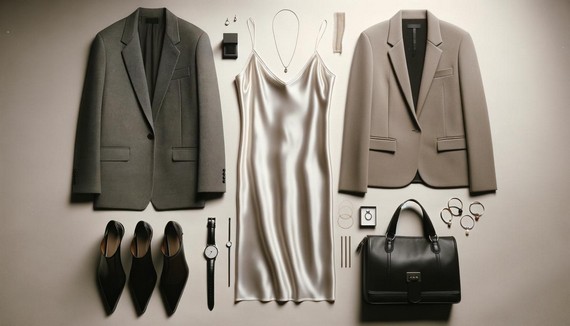
A fashion flat lay featuring key elements of 90s minimalist style: a slip dress, fitted suit, and streamlined accessories in neutral tones
Modern Influence and Revival
In today’s fashion landscape, the resurgence of 90s minimalism presents itself as a calming influence amidst shifting trends. This isn’t merely nostalgia-driven; it’s a conscious shift towards a more thoughtful and sustainable approach to style. The essence of minimalist 90s style—simplified silhouettes, neutral palettes, and a focus on quality—has been skillfully reincorporated into today’s wardrobe staples.
The streamlined silhouettes of the 90s now make their modern presence felt through clean-cut slip dresses and chic power shirts. These pieces have been transformed with subtle modern twists that add a contemporary edge while honoring the past. Silhouettes remain graceful and purposeful, showcasing the body without overshadowing it.
Neutral color palettes have retained their timeless appeal, transcending seasonal trends. In a world saturated with bold styles, the soothing hues of black, white, and grey allow fashion enthusiasts to curate versatile wardrobes that can shift seamlessly across occasions.
The ‘quality over quantity’ ethos has become a cornerstone of sustainable fashion today. This approach champions thoughtfully crafted garments over fast fashion’s fleeting indulgences—an ideal that resonates as we become increasingly conscious of our ecological footprint. Modern trends emphasize longevity through the use of durable, high-quality materials.
Elements of streetwear have merged with minimalist 90s styles, creating a hybrid that caters to the comfort-loving, style-conscious crowd. This fusion introduces a layer of practicality and approachability to refined designs, allowing minimalism to keep pace with street-level fashion trends.
The sustainability wave has complemented this minimalist revival, as both share the common goal of curating a conscious, clutter-free lifestyle. Minimalism’s restrained flair dovetails perfectly with reducing waste, encouraging investment in fewer, better-quality pieces that transcend fleeting fashion cycles.
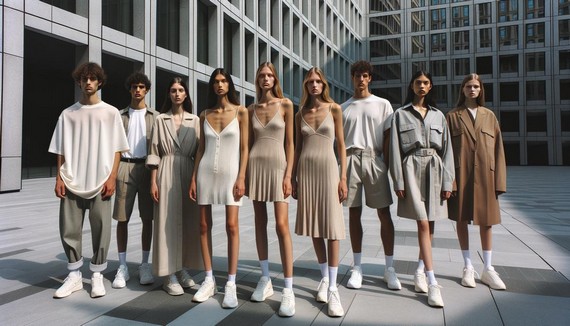
A contemporary fashion scene blending 90s minimalism with modern streetwear influences, showcasing clean-cut slip dresses and chic power shirts
In essence, 90s minimalism remains a testament to the idea that elegance can be found in restraint. It continues to influence modern fashion by promoting thoughtful choices over fleeting fads. As we look forward, this understated yet powerful minimalist 90s style reminds us that sometimes less truly is more.
- Hill C. Reinvention and Relentlessness: Fashion in the Nineties. New York: Rizzoli; 2021.
- L’OFFICIEL Archive. 1995 Trend Story: Minimalism Takes Hold. L’OFFICIEL. 1995.
Key 90s Fashion Trends – 90s Athleisure And Sportswear
Fashion is a curious thing, often weaving the past into the present in ways that both surprise and delight. The revival of 90s athleisure and sportswear exemplifies this key 90s fashion trend, as familiar silhouettes and styles find new life in today’s wardrobes. This resurgence speaks to a broader desire for comfort blended with style, where nostalgia meets modern sensibilities.
Evolution and Revival of 90s Sportswear
Fashion has always been a reflection of time, often intertwining past styles with modern nuances. As 90s athleisure and sportswear re-emerges, it’s clear that nostalgia influences today’s fashion landscape. Brands like Gucci, Prada, and Versace are embracing this resurgence, blending classic 90s elements with updated, luxurious details.
Gucci has brought stripes and varsity jerseys back from the 90s, injecting them with contemporary flair. Prada delivers tracksuits that allude to casual wear yet maintain a sense of glamour. Versace adds its signature splash of colour and pattern to the revival, reimagining 90s athleisure and sportswear with a modern twist.
This 90s athleisure and sportswear resurgence taps into the fashion world’s cyclical patterns. Consumers are drawn to the relaxed yet fashionable signature of the 90s, a time when fashion didn’t just meet functionality, but embraced it. This blend of old and new excites fashion-savvy youths, who find comfort in adopting styles from an era marked by individuality and experimentation.
Luxury brands are leveraging iconic elements like:
- Tracksuits
- Sports bras paired with wide trousers
- Oversized jackets
These 90s athleisure and sportswear pieces aren’t mere replicas, but fresh interpretations that respect their roots while catering to contemporary tastes. Streetwear has become the bridge, merging the athletic with luxury, allowing for daily wear that’s sleek yet relaxed.
90s athleisure and sportswear graphical motifs remain a favourite, offering a visual reminiscence of times gone by. Precise lines, vibrant colours, and playful designs dominate collections, turning sporty items into statements of style. This intricate dance between nostalgia and innovation fuels the fashion world, with every revisit harking back to a past era yet stepping boldly into the present.
90s athleisure and sportswear, now a staple of modern fashion, finds deep roots in this time-blending approach. Fashion connoisseurs find themselves delighted by options that blend heritage with new perspectives, offering attire that transcends mere trends.
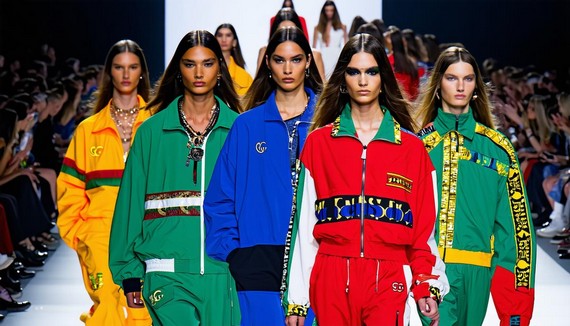
luxury tracksuit fashion show
Key Elements of 90s Athleisure
Oversized tracksuits, once the hallmark of any self-respecting 90s wardrobe, are making a spirited comeback in the 90s athleisure and sportswear scene. These staple pieces, beloved for their comfort and ease, epitomise the decade’s seamless blend of functionality and fashion. Today’s versions come updated with technical fabrics that speak to both athletic prowess and style, making them versatile enough for a stroll through the city or a casual weekend brunch.
Vintage sneakers have never really left the spotlight. With brands like Reebok, Nike, and Adidas digging into their archives, these shoes marry retro charm with modern sensibilities. Styles featuring leather overlays, bold logos, and thick soles are all the rage, positioning these trainers as both a fashion statement and a nod to nostalgia.
The colour palette of the 90s continues to inspire:
- Vivid reds
- Deep blues
- Striking whites
These hues often appear in graphic motifs and chevron patterns, reminiscent of tennis, golf, and soccer gear from the era. It’s a vibrant collection of colours that encourages playful expression and a break from the more muted tones typically associated with athletic wear.
Current trends have taken this retro 90s athleisure and sportswear base and elevated it, artfully merging athletic gear with casual and dressier fashion choices. A sporty track jacket over a fitted dress, or joggers paired with a crisp shirt and blazer, exemplify how the 90s influence is modernised. This versatility appeals to a broader audience seeking balance between comfort and chicness.
In reviving these key elements, 90s athleisure and sportswear underlines a broader fashion narrative: the longing for a personalised style that caters to both movement and appearance. The combination of retro aesthetics with cutting-edge fabrics ensures that while fashion pays homage to its past, it doesn’t lose sight of current trends.
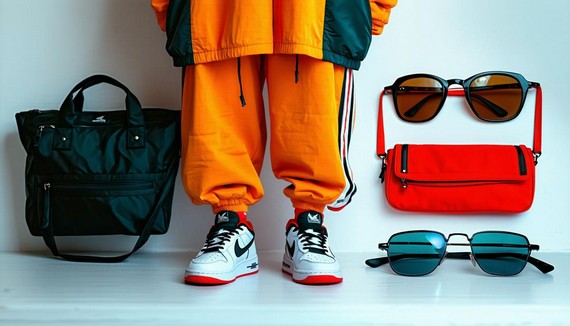
90s athleisure key elements
Impact on Modern Wardrobes
The fusion of athletic wear with everyday fashion has ushered in a new era of style—one where comfort and practicality are at the forefront. Athleisure has become an essential component of modern wardrobes, revolutionising the way individuals, particularly teens, approach dressing. The rise of athleisure is a sartorial phenomenon, where the boundaries between gym wear and streetwear blur in the most stylish way.
At the heart of this key 90s athleisure and sportswear fashion trends’s appeal is the pursuit of comfort. In today’s fast-paced world, where transitions from school to sports to social gatherings are frequent, having clothing that can gracefully adapt to varied scenarios is invaluable. Athleisure pieces—like leggings, joggers, and hoodies—have become the go-to for achieving that balance.
The cultural shift towards gender inclusivity has also played a pivotal role in moulding athleisure. Brands are increasingly designing pieces that transcend traditional gender norms, fostering inclusivity. Nike, a frontrunner in this domain, highlights innovative designs that cater to diverse body types and preferences, ensuring that everyone finds a fit synonymous with their style.
“We designed the collection for modern women on the move with an emphasis on casual daywear inspired by the off-duty ease of vintage muses” – Anine Bing
Social media platforms, including Instagram and TikTok, act as powerful tools in amplifying this trend. Influencers and celebrities showcase their athleisure looks, inspiring millions and reflecting a sartorial story where style meets comfort. This digital influence underscores the growing affinity for relaxed fashion, celebrating authenticity and individuality.
Athleisure encapsulates a broader fashion ethos: clothing that is comfortable yet chic, functional yet style-savvy. This key 90s athleisure and sportswear fashion trend speaks to not just a change in fashion preferences but a lifestyle evolution, where how we dress is an extension of our dynamic routines and diverse identities. As athleisure continues to weave itself into fashion, it reshapes our understanding of clothing as a conduit for confidence and self-expression.
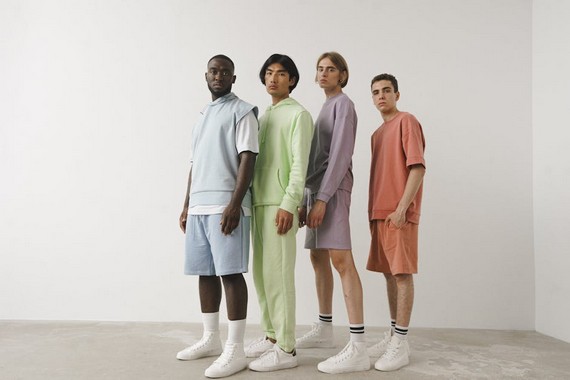
Athleisure everyday outfits
The enduring appeal of 90s athleisure and sportswear lies in its ability to connect generations through shared memories and evolving tastes. As these key 90s fashion trend styles continue to influence modern fashion, they remind us that while trends may change, the essence of personal expression remains timeless.
References:
- Piper Sandler Survey. Teen Consumer Insights Survey. 2023.
- Data But Make It Fashion. Denim Trends Report. Instagram. 2023.
- L’OFFICIEL. ’90s Sportswear Trend for Spring/Summer 2021. 2021.
Key 90s Fashion Trends – 90s Sportswear Revival
The appeal of 90s athleisure and sportswear is undeniable, offering a nostalgic nod to an era where comfort met style in a harmonious blend. This fashion movement, characterized by its relaxed fits and vibrant hues, has found its way back into contemporary wardrobes. It’s about embracing a timeless approach to dressing that prioritizes individuality and ease.
Elements of 90s Athleisure Wear
The 90s athleisure and sportswear scene was one of the key 90s fashion trends and a mix of comfort and style, embracing oversized fits and vibrant hues. Tracksuits, the unofficial uniform of cool, were everywhere. Designers like Adidas and Nike crafted zip-up jackets and matching pants from slick, swishy fabric. Patterns inspired by tennis, golf, and soccer featured graphic lines and chevrons.
Sneakers saw a rebirth too. The classic kicks of the decade included chunky and bold styles like Reebok’s Classic Nylon and Freestyle Hi. They blended leather and suede into a vintage comeback.
Accessories played their part in 90s athleisure and sportswear. The bucket hat added a splash of throwback charm, shielding wearers from the sun while remaining stylish on the street and beach.
Iconic pieces included:
- Oversized crewnecks teamed with bike shorts, reminiscent of Princess Diana’s style
- Varsity jackets blending comfort with college sports spirit
The beauty of 90s athleisure and sportswear lay in its effortless blend of sport and casual. Every piece offered a way to break traditional fashion rules, creating a world where the lines between rest and play blurred beautifully.
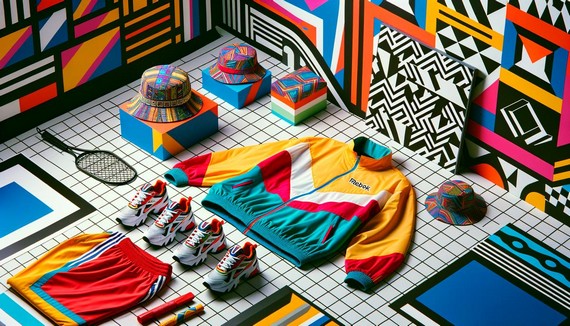
A collection of essential 90s athleisure items including a tracksuit, chunky sneakers, and a bucket hat, displayed on a retro-patterned background
Current Trends and Influences
Today’s fashion landscape echoes 90s athleisure and sportswear, proving that what’s old is new again. Modern designers are weaving these influences into contemporary wardrobes, celebrating comfort and individuality.
The collaboration between Anine Bing and Reebok exemplifies this key 90s fashion trend. It reignites the 90s It Girl aesthetic, fusing Reebok’s athletic legacy with Bing’s chic designs. The collection features updated classics like the Freestyle Hi sneakers in luxurious materials.
Celebrity endorsements have boosted the revival. Icons like Hailey Bieber champion retro-chic looks in high-profile photoshoots, influencing fashion enthusiasts worldwide through social media.
Technology has made these vintage 90s athleisure and sportswear styles more accessible. Visual search tools help fashion lovers find exact styles or similar garments with ease, combining historical authenticity with modern convenience.
This resurgence reflects a collective desire for simpler times, remixed for today. By blending past designs with current trends, the 90s sportswear movement continues to flourish, allowing people to express individuality through timeless styles.
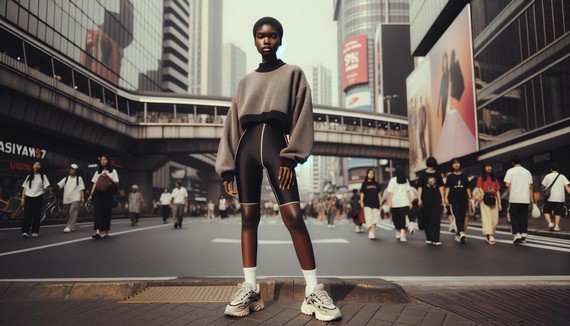
A young woman wearing a contemporary take on 90s sportswear, combining vintage and modern elements in an urban setting
Key 90s Fashion Trends – Sustainability and Nostalgia
The revival of 90s athleisure and sportswear intertwines with a growing commitment to sustainability. Today’s fashion world aligns the decade’s practical yet stylish clothing with eco-friendly practices, where longevity trumps fleeting trends.
Reimagining vintage 90s pieces through a sustainable lens involves more than design nostalgia. Brands like Reebok and Anine Bing incorporate:
- Recycled materials
- Sustainable sourcing
These practices breathe new life into classic styles while reducing environmental impact.
This key 90s athleisure and sportswear fashion trend allows wearers to forge a unique connection to the past while making eco-conscious choices. The relaxed yet adaptable traits of 90s fashion offer a canvas for expressive, sustainable style. Vintage-inspired sportswear becomes a dialogue between generations, blending familiar aesthetics with forward-thinking practices.
Incorporating such fashion into modern wardrobes cultivates a mindful approach that respects the past while sustaining the future. It’s about rekindling old styles with a sense of responsibility that aligns with the world’s need for positive change.
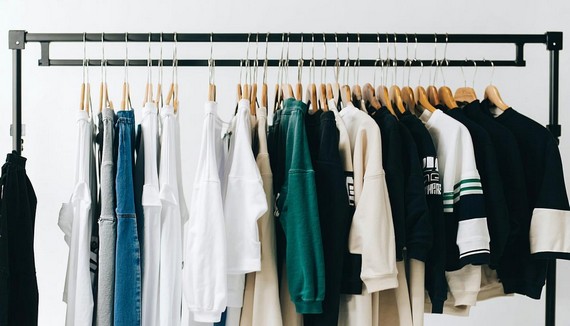
A rack of sustainable, 90s-inspired athleisure wear made from recycled materials, showcasing eco-friendly fashion practices
As we embrace 90s athleisure and sportswear in our modern lives, we participate in an ongoing story where style meets sustainability. The key 90s fashion trends represent a connection between past and present, allowing us to express ourselves with garments that blend heritage and innovation in the most authentic way.
- Piper Sandler Survey. Teen Consumer Insights. 2024.
- Global Sources. Streetwear Trend Report. 2024.